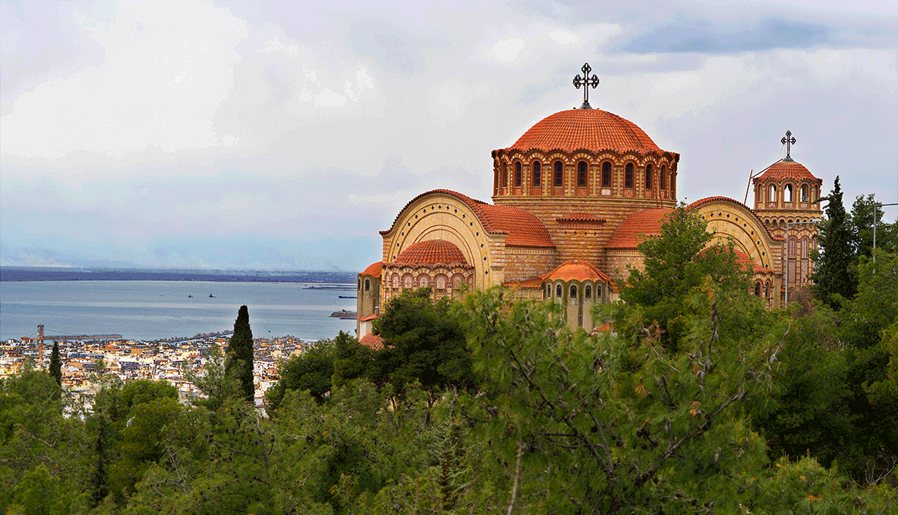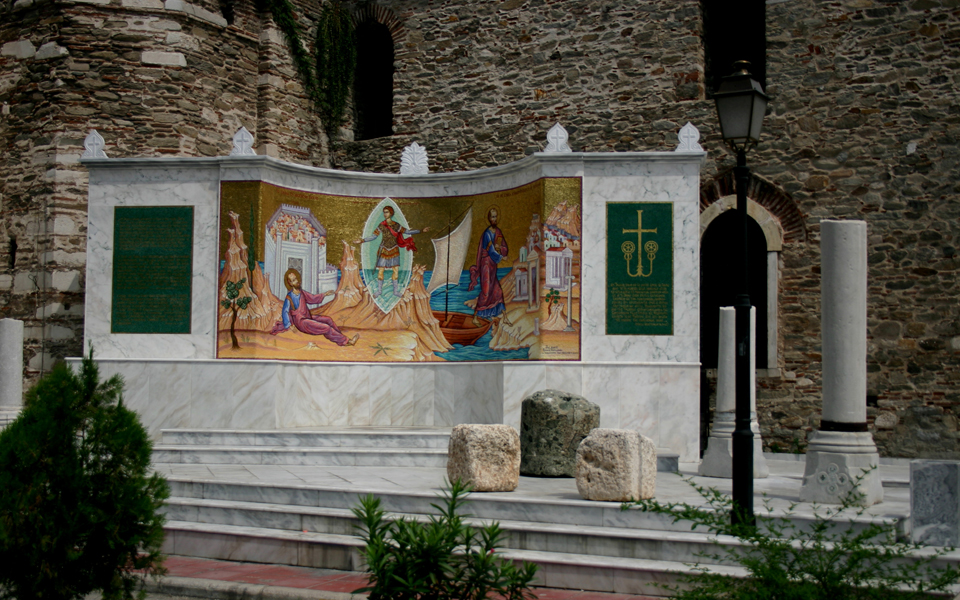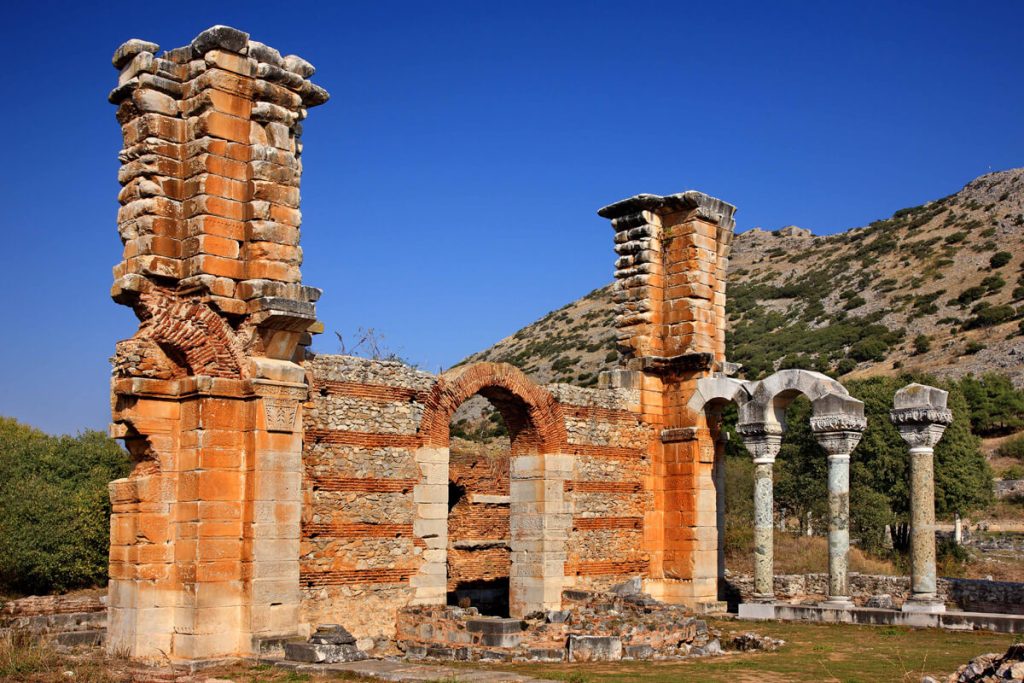Kavala - Filippoi
Estimated Duration
10 Hours
Estimated Distance
490 Km

Church of St. Paul
At the district of St Paul, northeastern of Thessaloniki, dominates the majestic church dedicated to the Apostle of the Nations, since the area is related to his passing from Thessaloniki in 50 AD.
According to tradition, in this area, east of the later Monastery of Vlatadon, at the foothills of Kedrinos hill, there was a spring of water where the Apostle drank some water, when the residents helped him escape from the walls of the city on his way to Veroia. The spring became known as the “holy spring of Apostle Paul” and was an area of pilgrimage for the believers for centuries. During the period of the Turkish occupation, in 1875, the Greek community granted the area to the Charitable Brotherhood of Men of Thessaloniki and after the liberation of the city as small church was built dedicated to Apostle Paul.
The church was designed by the architect Xenophon Paionidis and was inaugurated on the 10th of April 1922, Sunday of Thomas. During the decade of 1970 the modern majestic church was constructed a bit higher.
Today at the estate of the Charitable Brotherhood of Men of Thessaloniki, at the shadow of the impressive large church, one can visit the small church, to wander in the beautifully shaped area of the yard, to see the point where, according to tradition, Apostle Paul rested, to follow the path until the tribune and the holy spring and admire the view to Thermaic Gulf. Since 1922 the church has been the focus of a brilliant celebration on the day of celebration of Peter and Paul, on the 29th of June. Nowadays, each summer they carry out the Agiopaulitika, a three-day celebration that combines the religious events with folk tradition and modern culture.

Apostle Paul’s Altar
Saint Paul or the Saint of the Nations, as he is called nowadays, came to Veria in 50-51 after Christ. He preached the Christian faith in Veria twice, at the point, where today stands a Podium dedicated to his sainthood.
In the first period of Christianity, the place where nowadays stands the Podium, was located outside the walls of the town. This is the touchstone of the ecclesiastic history of Veria.
The edifice, where the Apostle Paul’s Altar is located, is made of stone and is decorated by three big, magnificent, multicolor tessellations. Every year, in June, religious rituals take place, known as “Pavlia” and their high point is in the evening of the 29th of June with the outdoor evensong, during which the litany of Saint’s sacred image is being held.

Pilgrimage of Agia Lydia of Phlippians
In Krinides of Kavala, near the ancient city of Philippi, is the unique, monumental pilgrimage of the Equal-to-Apostles Saint Lydia of the Philippians, a modern monument, inspired by the important presence of Apostle Paul in the area.
According to the narration of Luke the Evangelist, Apostle Paul arrived in Philippi, the most important city of the area in the winter of 49-50 AD, during his first travel to Greece. He visited the place where the few Jews gathered every Saturday, at the banks of the river Zigaktis. Here, for the first time that women heard him preach, among them Lydia from Thyateira in Asia Minor, a merchant of purple dye for textiles. Lydia was the first Greek woman and the first European who was baptized a Christian by Paul together with her family and then she herself helped spread Christianity.
In memory of this great event, they erected in 1974 the church-baptistery by the then metropolitan of Philippi, Neapolis and Thasos Alexandros. The plans were made by the architect Ioannis Koumanoudis, while the project was carried out by the architect engineer Christos Batsis. The baptistery has the shape of the octagon. At its centre there is the marble bowl where they baptize infants, while at its two sides there are changing rooms for the adults that are going to be baptized. Its interior is decorated with many and impressive works of art, mosaics, icons, stained glasses, the creation of important artists, who narrate the events that took place during the presence of Apostle Paul in Philippi.
At the banks of the river, at the location where according to tradition Lydia was baptized, there is an outdoor baptistery, shaped as a cross, like the ones surviving at the Early Christian basilicas at Philippi. Here, every year, on the 20th of May, day of celebration of the memory of Agia Lydia, they baptize adults.

Basilica B of Filippi
On the south side of the Roman market is built the northern wall of Basilica II and they were connected to each other by an entrance opened in it. The church belongs to the type of basilica with a dome, which covered the sanctuary and the space in front of it. Two colonnades with 6 columns each divided the interior into three naves, with an overall width of 31 m. The middle nave was housed by a large arch. The beginning of the arches that supported it can be seen high up on the pilasters. Above the side aisles and the narthex was the women’s nave, which had the form of a P. The marble pillar of the chancel is preserved in its place, and the sanctuary on its eastern side has a large semicircular arch. Symmetrically to the sanctuary arch are built two small arches in the NE and SE. corners of the church, belonging to the annexes.
To the NE, is the baptistery, a square room (6.89 x 5.57m). Its floor, once paved with tiles, has in the middle a square shallow basin (2.51 x 1.83m.), fitted with a drain for water drainage. The baptistery communicates to the east with a narrow long room ending in a small archway. This room was used during the Baptismal ceremony and may have been a catechism room or chrismarium.
In the SE. corner there is a room which was probably the deacon’s room of the church and when it was destroyed the room was converted into a chapel. The three naves of the church communicate with the narthex by three entrances. With the destruction of the basilica, the narthex, which remained intact, was transformed into a small church, and with the arch the sanctuary of the temple was created.
No atrium was built, although a large space was prepared for it. Without it, the length of the church is about 62 metres and its width including the annexes about 47 metres. For its architectural type and decoration, the famous churches of Constantinople, Agia Sophia and Agia Irene, served as models.
Excellent examples of decorative art are the capitals, the epikrana and the epitaphs. Wide acanthus leaves spread out on the basket of the capitals and logical folios are the decorative themes. The drill carved the contours deeply so that the marble looks like lace.
The great and beautiful Basilica II, at the central point of the city of Philippi, was built in 550 AD or a little later. But before the landscaping of the interior was completed, the dome collapsed. What remains are the imposingly raised side walls, worn down by time and people.

